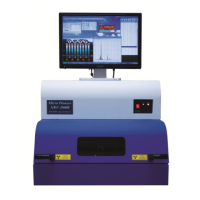XRF-2000 Series Operating Manual
7
1.2 Principles of Operation
XRF-2000 Series systems utilize the phenomenon that when a sample is
irradiated with x-ray radiation, the sample’s atoms are excited. As the
atoms return to their stable state, they emit x-ray photons (X-ray
Fluorescence – XRF).
Each element has its distinct characteristic emission lines. The energy of
these lines are documented in tables and stored in the computer’s
memory. A given sample’s elements are identified by comparing the lines
in the acquired spectrum to the corresponding element lines listed in the
system’s database.
The intensity (magnitude) of the element’s lines in the acquired spectrum
is related to its concentration or thickness. Increasing the concentration
or thickness of an element result is an increase in the intensity of the
fluorescent radiation characteristic of that element. By using empirical or
theoretical physical models, the system can provide precise qualitative
and quantitative analysis or thickness measurement.
XRF-2000 Series systems employ a proportional counter or Si PIN diode
detector to detect x-rays emitted from the sample. These detectors are
capable of acquiring a spectrum containing many lines from many
elements simultaneously. The counters or detectors convert the x-ray
photons to proportional electric pulses. These signals are amplified and
converted into a digital form by the Analog-to-Digital Converter (ADC).
The data of the accumulated spectra are stored and displayed on the
computer’s monitor as a spectra histogram.
Besides characteristic lines, any observed spectrum also contains
background signals, their characteristic dependent on many factors,
especially excitation conditions. In order to reduce background and
increase useful signal, X-ray high voltage and emission current can be
varied, as well as utilizing changeable special filters. All these allow
optimizing the spectrum of exciting X-ray beam for any given application.
ED-XRF analysis tools enjoy the following advantages:
Broad concentration range from ppm (mg/Kg) levels up to 100%.
Sensitivity to all the elements in the periodic table from
Magnesium to Uranium.
Fast response: Typical analysis time is usually under a few
minutes.
Simultaneous analysis of many elements.
Non-destructive: The X-ray radiation does not leave any effects in
the sample after analysis. Rare or precious samples are well as
calibration standards can be tested an unlimited number of times
without losing any of their authentic properties.
Flexibility of sample form: The sample may be in solid, powder,

